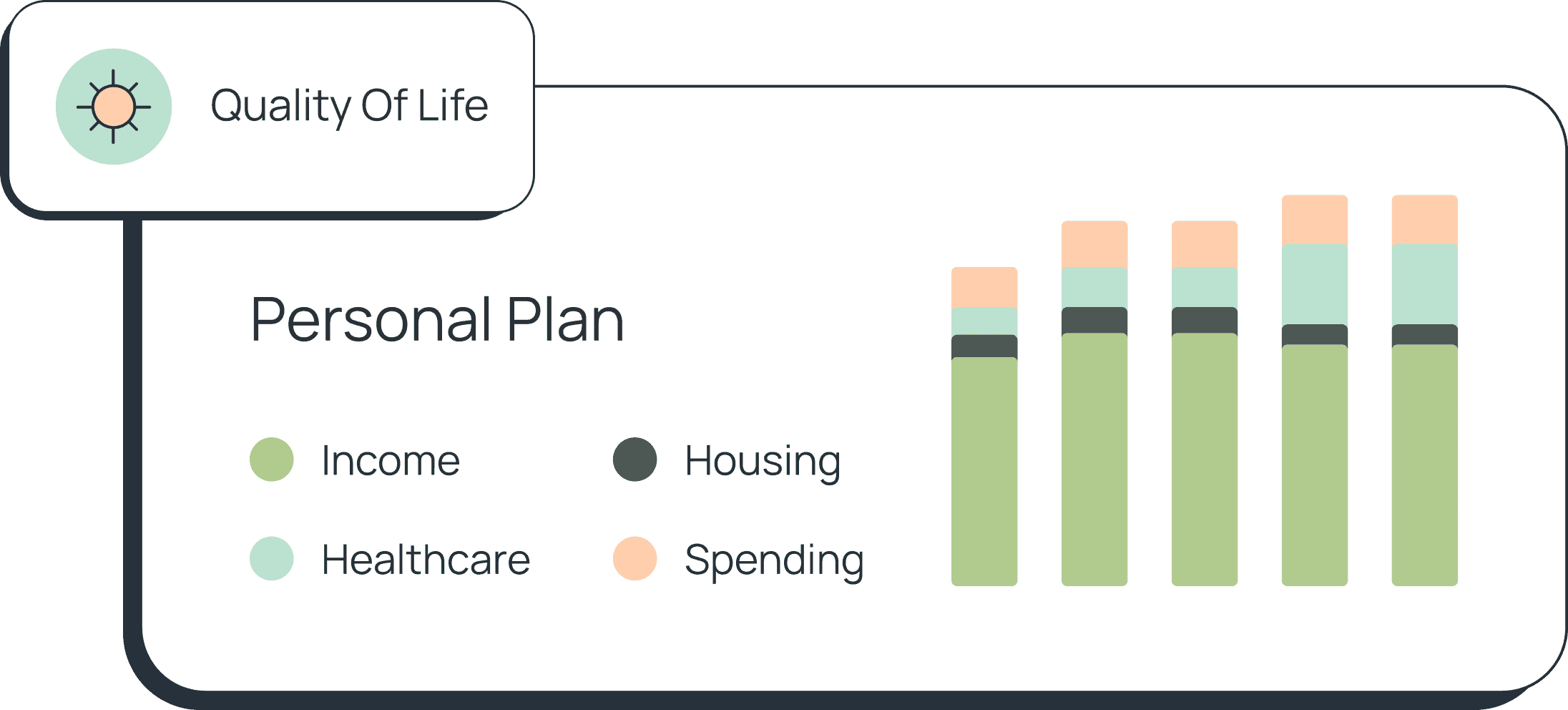Lifestyle
The current rate of inflation may seem bad, but it’s nowhere near the levels several currencies have during periods of true hyperinflation. Discover why hyperinflation is different from inflation, and which countries have suffered the worst periods of hyperinflation of all time.

C.E Larusso
•
Published November 14th, 2024
•
Updated November 15th, 2024
Table of Contents
Key Takeaways
The current rate of inflation may seem bad, but it’s nowhere near the levels several currencies have during periods of true hyperinflation.
While the United States has experienced extreme levels of inflation—both during wartime—it has never experienced hyperinflation.
The most recent case of hyperinflation was Venezuela, exceeding an increase of 1,000,000% from 2013 to 2018.
Inflation is a normal part of the economy, causing the price of goods to rise gradually over time. However, when inflation spirals out of control—rising more than 50% per month—it becomes hyperinflation. Throughout history, over 50 nations have suffered from hyperinflation, leading to economic collapse, extreme poverty, and social unrest. The most severe cases include Hungary, the Weimar Republic, Zimbabwe, and Yugoslavia.
What Causes Hyperinflation?
Hyperinflation doesn’t happen overnight—it’s usually the result of poor economic policies, war, or political instability. The most common causes include:
- Excessive Money Printing – When governments print too much money without backing it with real value, inflation skyrockets.
- Loss of Confidence in Currency – If people don’t trust the stability of their country’s money, they will rush to convert it into foreign currency or goods, causing a collapse in value.
- War & Economic Collapse – Post-war reparations, destruction of infrastructure, and sanctions can accelerate hyperinflation.
- Corruption & Mismanagement – Poor financial policies and lack of regulation can erode an economy’s foundation.
Each of the cases below suffered from one or more of these factors, leading to financial disaster.
How Hyperinflation Impacts Daily Life
Hyperinflation destroys a country’s economy, but its effects on ordinary citizens are even more devastating:
- Basic necessities become unaffordable – Food, medicine, and housing costs skyrocket beyond the average person’s income.
- Savings become worthless – A lifetime of savings can lose all value in just months.
- Bartering replaces currency – In extreme cases, people abandon cash and trade goods directly.
- Businesses shut down – Companies can’t keep up with daily price changes, leading to mass unemployment.
- People flee the country – Economic refugees seek stability in other nations.
Many of these effects were seen in Hungary, Zimbabwe, and Venezuela, where people used foreign currencies, gold, and even food as makeshift money.
1. Hungary: August 1945–July 1946
Max inflation rate: 13,600,000,000,000,000%
Prices doubled every: 15.6 hours
Hungary’s period of hyperinflation is the worst ever recorded. After World War II, the country was economically devastated, with 40% of its capital stock destroyed. During the war, it took on an enormous amount of debt to aid Germany in the war effort, but Germany never paid its bill, leaving Hungary in a dire situation.
Hungary holds the record for the worst hyperinflation in history. After World War II, the country’s economy was in ruins:
- 40% of its infrastructure was destroyed, leaving industries crippled.
- Hungary had borrowed heavily to support Nazi Germany, which never repaid its debts.
- The Soviet Union demanded massive reparations, taking nearly 50% of Hungary’s budget.
- The government responded by printing trillions of pengő, causing its value to collapse.
Once Hungary signed a peace treaty with the Allies in 1945, it was ordered to pay reparations to the Soviet Union, which they had fought alongside the Nazis—some economists estimate the reparations accounted for nearly 50% of Hungary’s budget, or $300 million dollars.
At its worst, prices doubled every 15 hours. A loaf of bread that cost 6 pengő in 1945 skyrocketed to 6 billion pengő in mid-1946. To stabilize the economy, the pengő was abandoned, and the forint was introduced on August 1, 1946—which is still Hungary’s currency today.
Causes of Hungary’s 1946 Inflation
After World War I, the Austro-Hungarian empire was dissolved, and the new, independent nation of Hungary lacked a sturdy state structure. To replace the Austro-Hungarian Krone, Hungary printed the korona, but that suffered a high rate of inflation in the 1920s and was ultimately replaced by the pengő.
The Great Depression had a significant impact on Hungary, especially its agricultural sector. The pengő was initially stable but the economic crisis coupled with the events of World War II quickly caused the value of the pengő to quickly deflate.
After the war, the government started to rapidly print money to get more currency in circulation and levy taxes. In July of 1945, there were 1.6 trillion pengő in circulation, and by January 1946, 65 quadrillion. With too much currency floating around, the prices of goods skyrocketed and the pengő lost its value. Something that cost 379 pengö in September 1945 cost 11.267 billion pengö by May 31 of the same year.
To deal with the pengö’s plummeting value, Hungary’s government introduced new currencies. The pengö was replaced by the mpengö, and that was replaced by the bpengö, followed by the adópengő. Eventually, the currency, completely decimated, was replaced by the forint on August 1, 1946; the Forint is still in circulation today.
2. The Weimar Republic: 1922–1923
Max inflation rate: 29,500%
Prices doubled every: 3.7 days
The story of the Weimar Republic’s period of hyperinflation is one of the most well-known on this list. After World War I, Germany’s economy was rocky; the country believed it would win the war and spent a hefty amount on its military efforts. After the war, the Treaty of Versailles demanded that Germany pay reparations that it could not afford, and also asked it to fire thousands of its soldiers—leaving large numbers of people without work.
By September of 1920, prices for goods were approximately 12 times higher than they had been before the war. By September of 1922, the same basket of food that had cost 270 marks in April of that year now cost 2,615 marks.
Some municipalities started to pay their workers in their own unique currencies, worried that workers would become aggravated if their salary was delayed and the mark depreciated further before they could spend their money. Some workers were paid twice a day because a payment that was issued in the morning would be worth significantly less by the time lunch rolled around.
This period of hyperinflation is often cited as a major reason that enabled Adolf Hitler to come to power.
Causes of the Weimar Republic’s Inflation
The Weimar Republic was already on bad footing following the war, and when it defaulted on its reparations payments, France and Belgium sent military troops into the Ruhr Valley to confiscate industrial goods, such as coal mines, railways, and factories. The German government ordered workers to strike and not cooperate with the French and Belgians; the result was a dramatic reduction in goods being produced, while at the same time, the Republic was printing additional currency to pay the striking workers, further devaluing the mark.
3. Zimbabwe: March 2007–November 2008
Max inflation rate: 79,000,000,000%
Prices Doubled Every 24.7 hours
Zimbabwe’s period of hyperinflation was the first of the 21st century. In April 1980, the independent Republic of Zimbabwe was established in the ashes of the colonial state of Rhodesia, after a fifteen-year war of independence waged against the United Kingdom. The country at first experienced growth, stability, and development, with an economy based largely on wheat and tobacco production.
Zimbabwe’s hyperinflation crisis in the early 2000s was driven by:
- Uncontrolled money printing – The government produced excess currency without economic backing.
- Land Reform Policies – A controversial land seizure program reduced food production, crippling exports.
- Sanctions & Global Isolation – Western sanctions further strained the economy, cutting off foreign investment.
Over the course of the 1990s, Zimbabwe’s government, led by Robert Mugabe, attempted a series of structural adjustment programs designed to wrest control of the economy away from the white colonizers who retained control over the majority of the country’s land and resources even after the end of de jure white supremacy. These efforts were punished by severe sanctions imposed by the IMF and World Bank, the United States, and many other wealthy countries. These penalties, along with the array of growing pains and difficulties created by the attempt to remake the country’s economy from scratch tanked the country’s productive capacity and hobbled its banking sector, cutting it off from much of the international market. Much of the wealthy colonial elite left the country and brought with them the capital that they had accrued by exploiting Zimbabwe’s resources.
The government began printing currency beyond amounts its banks or the state could really back. The amounts ballooned further as Zimbabwe became embroiled in expensive wars in the Democratic Republic of Congo in the 2000s—and levels of financial corruption within the government soared. By the early 2000s, excessive currency printing and the widespread understanding both in the country and throughout the world economy that Zimbabwean banknotes had no stable value had resulted in inflation rates that climbed well north of 100% year-on-year.
Causes of Zimbabwe’s Inflation
Caught within a world order that would not allow the country to pursue its preferred aims, Zimbabwe faced the choice between the destruction of its economy by international institutions or relenting on its policies. It chose the latter and financed its efforts through the excessive production of currency. Deep governmental corruption and efforts to implement dramatic changes to the economy too swiftly destabilized the country further. These complex factors created a situation in which prices rose quickly and erratically to try to meet the devaluation of currency through oversupply—at the same time that the productive capacity that could give that currency stability was being decimated.
Without any clear measure of how much currency is in circulation or the true value of the country’s economy, the Zimbabwean dollar remains unstable and prone to hyperinflation. In cooperation with various international institutions, the country has experimented with solutions including the adoption of foreign currencies and convertible coins. The results of the 2020 COVID-19 crisis have lead to the resumption of hyperinflation in Zimbabwe.
4. Yugoslavia: March 1992–January 1994
Max inflation rate: 313,000,000%
Prices Doubled Every: 1.41 days
Yugoslavia experienced the second-worst period of hyperinflation on record, right after Hungary. After the dissolution of the Socialist Federal Republic of Yugoslavia, the Federal Republic of Yugoslavia was created, comprising the territories which are today the Republics of Serbia and Macedonia. In April of 1992, the United Nations Security Council imposed sanctions on the FR Yugoslavia as a result of its involvement in the war in Bosnia and Herzegovina. The sanctions, as well as political corruption under Slobodan Milosevic, caused a major economic crisis, and hyperinflation ensued.
To end the economic crisis, which caused many Yugoslavians to wait in enormous lines for food, the country upended its financial policies and its currency (the dinar). In 2006, after the Yugoslav wars, the state of Yugoslavia dissolved when Serbia and Montenegro became independent states.
Causes of Yugoslavia’s Inflation
From 1971 to 1991, Yugoslavia was already in pretty bad shape, with an annual inflation rate of 76%. In January of 1991, things got much worse when Slobodan Milosevic ordered the Serbian National Bank to issue over $1 billion in credit to his friends. This amount was over half of the amount of money that the National Bank of Yugoslavia planned to issue in 1991; this move emboldened the leaders of Croatia and Slovenia to break away from the SFRY.
At this point, over 80% of Yugoslavia’s budget was sent to the military and police, as ordered by Milosevic, who continuously printed dinars to pay for these expenses. Between January of 1991 and April of 1998, the dinar was devalued 18 times.
What Countries Are at Risk of Hyperinflation Today?
While hyperinflation is rare in modern economies, some countries face high inflation risks today:
Venezuela – Entered hyperinflation in 2013, with inflation rates exceeding 1,000,000% in 2018.
Argentina – Inflation exceeded 200% in 2023, sparking fears of economic collapse.
Lebanon – Suffering from triple-digit inflation and a collapsing currency.
Global events like wars, recessions, and unstable leadership could trigger new cases of hyperinflation in the future.
Hyperinflation FAQs
Who suffered the most in hyperinflation?
Hyperinflation affects everyone, but working-class individuals and retirees suffer the most as wages become worthless and savings evaporate. Job losses rise as businesses shut down, and essentials become unaffordable.
Some middle-class homeowners may benefit if property values increase, and borrowers gain as debts lose value. However, overall economic instability makes survival difficult for most.
What was the most recent hyperinflation?
Venezuela entered a state of hyperinflation in 2013; by 2018, inflation had increased 1,000,000%.
Has the US ever had hyperinflation?
While the United States has experienced extreme levels of inflation, both around the time of wars, it has never experienced hyperinflation.
Between 1776 and 1778, the inflation rate was 29.78%, and since the introduction of the Consumer Price Index, the highest level of inflation on record was 20.49% in 1917. These timeframes correlate to the United States participating in the Revolutionary War and World War I.
Share this advice

A professional content writer, C.E. Larusso has written about all things home, finance, family, and wellness for a variety of publications, including Angi, HomeLight, Noodle, and Mimi. She is based in Los Angeles.
Share this advice

A professional content writer, C.E. Larusso has written about all things home, finance, family, and wellness for a variety of publications, including Angi, HomeLight, Noodle, and Mimi. She is based in Los Angeles.
Retiring In The Next 3 Years?
Increase your monthly retirement income for simplicity, security, and peace of mind.




